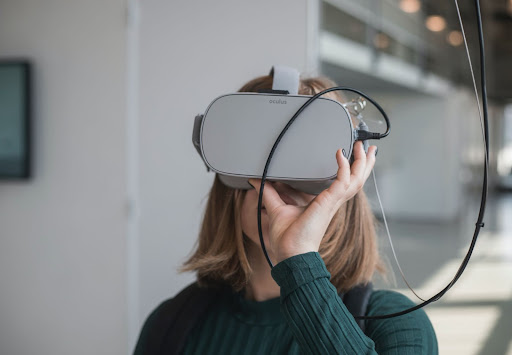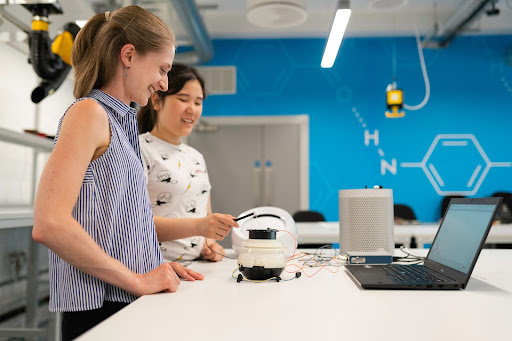Technology’s Role in Enhancing the Education Experience
Since the beginning of education, students have sat in classrooms with a teacher at the front, solving math problems, reading, and monitoring their work. While the education system is a hot debate topic, you can’t deny that the way we’ve been doing it has been effective enough at teaching the younger generations. However, in recent years, we’ve seen a shift from traditional in-person classrooms to digital environments that weren’t possible just a few decades ago.
Additionally, technology has enhanced the learning experience online and off, with teachers consistently finding new ways to use technology to educate students. While education doesn’t evolve alongside technology like marketing, healthcare, or manufacturing, it does clearly impact learning.
Does Technology Enhance the Education Experience?

Technology is a tool for learning. It can’t solve some of the major issues in our current school systems, but it can help students learn more effectively. Unfortunately, educational technology largely depends on how it’s used, much like a textbook. If students aren’t actively engaged, no amount of technology can teach them.
That said, integrating technology into the classroom may help students stay engaged and help teachers find more effective teaching methods by enabling a more personalized experience. Technologies like purely online classrooms, augmented reality (AR), videos, and other types of educational tools can make classes more interesting and engaging. Additionally, the use of some of these technologies can help teachers more accurately track students’ progress using more than just grades. Here are some ways education benefits from technology:
Homework Assignments
Online classes with teachers and other students can help students learn as effectively as in-person classes. Additionally, this technology helps students track their homework assignments using different applications that allow them to track deadlines and upload homework. Students can no longer use the “dog ate my homework” excuse, holding them more accountable for their grades and actions.
Student Engagement
Technology is part of everyone’s life, so why wouldn’t you see it in the classroom? Unfortunately, many classrooms around the globe are still stuffed with out-of-date books and old televisions, only used when there’s a substitute teacher. Utilizing technology in the classroom can help students stay engaged because technology is already a significant part of their lives. Luckily, reading is still a popular pastime among children, but textbooks aren’t the most effective way to teach young minds, especially in a world impacted so much by technology.
Technology in a classroom can make activities more enjoyable and engaging. For example, teachers can use augmented reality (AR) and virtual reality (VR) to teach just about anything from math to anatomy. In addition, the more engaged students are, the more likely they are to learn and memorize course materials, and the appropriate use of technology can improve their grades and motivation.
Collaboration
In a traditional classroom setting, students sit at single desks with their noses in books. However, in a technology-based setting, students and teachers can collaborate more closely during lessons to solve problems. Instead of preaching to the classroom, teachers can work together with their students to make course material more memorable through educational games and online classes.
Technology also encourages students to work closely with their teachers. Teachers might have after-hours tutoring sessions with struggling students in a traditional classroom. However, in a digital environment, students can get assistance at any point during the day by uploading their homework and asking questions to facilitate better, more efficient learning.
Personalization
Many students indeed thrive in large classrooms, but this isn’t true for everyone. Some of the smartest students fall behind in less personalized settings. However, technology can provide a more personalized learning experience for children with more convenient lessons to replace traditional teaching methods. Instead of going to school, taking notes, and coming home, students can review their coursework online in case they missed anything. For example, teachers can record their lectures and let students rewatch them to help them learn.
Additionally, technology can provide a more tailored approach based on a student’s preferred learning environment. For example, one who learns better online when they can review course material at any time of day can have access to a digital classroom environment complete with textbooks and homework assignments they can complete in advance to learn at their own pace.
We’ve already seen how learning at your own pace has impacted students regardless of their age. For example, some colleges and universities have online courses that allow students to learn at their own pace as long as they complete their coursework by a certain deadline.
Automation
The education experience doesn’t just impact students; it affects teachers. In our current education environment, public school teachers are overworked. They wake up early in the morning, go to work, and spend late nights at school grading papers, or they take their work home with them. Technologies like robotic process automation platforms might be able to help by performing routine tasks human teachers usually do, such as taking attendance, reporting grades, and even grading homework assignments to reduce at least some of the burdens.
Digital vs. Traditional Learning: Which is better?
Technology has already transformed the way we teach students. However, we shouldn’t be asking ourselves whether digital classrooms will take over traditional ones. Instead, we should focus on how we can enrich and improve the learning experience using technology. Online learning isn’t right for everyone, but neither is the traditional classroom setting. Can technology bridge the gap between these two learning environments? Only time will tell.
There’s no denying that technology will continue to impact the educational system, but just how that will happen is only a matter of speculation. That said, we shouldn’t view technology as a threat to traditional education; instead, it’s a tool that can help us better educate future generations with tools that facilitate learning.
Students are already using technology at home, so it makes sense for them to use it in the classroom. Unfortunately, we still have schools in the US that don’t have access to books or school supplies, so we lack the infrastructure to get this helpful technology into every school to help students learn. Will digital learning take over? Probably not, but technological learning tools are the way of the future.


